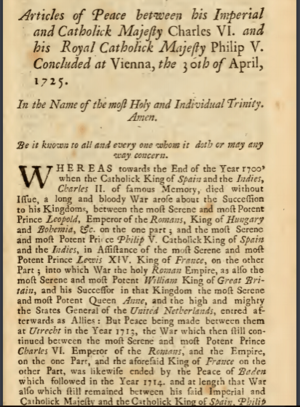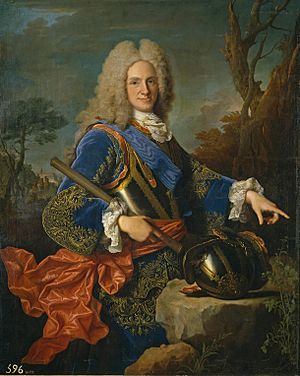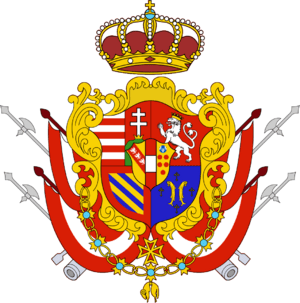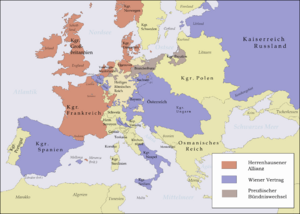Peace of Vienna (1725) facts for kids
| Articles of Peace between his Imperial and Catholic Majesty Charles VI. and his Royal Catholic Majesty Philip V. Concluded at Vienna, the 30th of April, 1725. | |
|---|---|
 |
|
| Type | Peace, Defensive Alliance, Commerce |
| Context | Stately Quadrille |
| Signed | 5 November 1725 |
| Location | Vienna, Austria |
| Effective | 26 January 1726 |
| Expiry | 16 March 1731 (alliance only) |
| Negotiators |
List
|
| Signatories |
List
|
| Ratifiers | |
| Languages | Latin, Spanish, French |
The Peace of Vienna (also known as the First Treaty of Vienna) was a group of four important agreements. These treaties were signed between April 30 and November 5, 1725. They involved the powerful Habsburg monarchy (which ruled Austria and the Holy Roman Empire) and Bourbon Spain.
Later, in 1726, the Russian Empire also joined this new partnership. This series of treaties created a strong alliance between Austria and Spain. It also led to a conflict called the Fourth Anglo-Spanish War (1727-1729).
The agreements also meant that the Habsburgs officially gave up their claims to the Spanish throne. In return, Spain gave up its claims to the Southern Netherlands and other areas. The treaties also set up new rules for trade between Austria and Spain.
A key part of the trade agreement was Spain's recognition of the Ostend East India Company. This company was allowed to dock and refuel its ships in Spanish colonies. While the public treaty was a defensive alliance, a secret agreement later in the year created a full partnership between the two nations.
Contents
- Peace Agreements
- Friendship Between Spain and the Empire
- Claim to the Kingdom of Sardinia
- Upholding the Peace of Utrecht
- Habsburgs Give Up Claim to Spain
- Spain Gives Up Claim to Sicily
- Spain Gives Up Claim to Southern Netherlands
- Succession in Tuscany
- Spanish Concessions in Livorno and Elba
- Spain Recognizes the Pragmatic Sanction
- Trade Agreements
- Defensive Agreements
- See also
Peace Agreements
Friendship Between Spain and the Empire
After the War of the Quadruple Alliance (1717-1720) and the earlier War of the Spanish Succession (1700-1714), Austria and Spain wanted a lasting peace. Even though there were earlier peace deals, both countries felt it was important to make new agreements. These new agreements would solve problems that directly affected both nations.
Claim to the Kingdom of Sardinia
Before the War of the Spanish Succession, the Kingdom of Sardinia was always ruled by the King of Spain. But in 1708, during the war, Austrian forces took control of Sardinia. The crown then went to Charles VI.
In 1720, Sardinia was given to Duke Victor Amadeus II of the House of Savoy. It then joined with other lands to form the Kingdom of Sardinia-Piedmont. As part of the Peace of Vienna, Charles VI officially gave up his claim to the Kingdom of Sardinia.
Upholding the Peace of Utrecht
A very important part of the Peace of Utrecht was that the new Spanish Bourbons could not become kings of France. And the French Bourbons could not become kings of Spain. This rule stopped France and Spain from ever being ruled by the same person. This agreement was confirmed again at Vienna, showing how serious it was.
Habsburgs Give Up Claim to Spain
Emperor Charles VI also gave up all his family's claims to the Kingdom of Spain. This meant that King Philip V was officially recognized as the rightful King of Spain. Charles was following the example of Philippe, Duke of Orléans. Philippe had also given up his claims to the Spanish throne ten years earlier in the Peace of Utrecht.
The treaty stated:
"By virtue of the said Renunciation, which his Imperial Majesty made for the sake of the general Safety of Europe, and in consideration that the Duke of Orleans had renounced, for himself and his Descendants, his Rights and Pretensions to the Kingdom of Spain, on Condition that neither the Emperor, nor any of his Descendants should ever succeed to the said Kingdoms; his Imperial and Catholic Majesty acknowledges King Philip V. for lawful King of Spain and the Indies; and will likewise let the said King of Spain', his Descendants, Heirs and Successors, Male and Female, peaceably enjoy all those Dominions of the Spanish Monarchy in Europe, in the Indies, and elsewhere, the Possession whereof was secured to him by the Treatys of Utrecht..."
Spain Gives Up Claim to Sicily
The Kingdom of Sicily used to belong to Spain, just like Sardinia. Austrian forces took control of Sicily during the War of the Spanish Succession. In the Peace of Utrecht, Sicily was given to the Duke of Savoy.
However, in 1717, during the War of the Quadruple Alliance, the Austrians took Sicily again. This time, Victor Amadeus II was an ally of the Empire. Spain had invaded Sicily to try and get it back. So, Philip V gave up his personal and family claims to the Kingdom of Sicily.
Sicily's Future
Just ten years later, Sicily would change hands again. Charles I de Bourbon, who was the Duke of Parma, conquered Sicily from the Austrians. This happened during the War of the Polish Succession (1734-1735). Charles was crowned 'Charles V' as King of Sicily in 1735.
Charles later became King of Spain as 'Charles III' in 1759. This happened after his father, Philip V, passed away. Charles then had to give up his Italian lands to his son, Ferdinand I.
Spain Gives Up Claim to Southern Netherlands
Before 1714, Spain owned a part of the low-country territory known as the Spanish Netherlands. Spain had owned this land since Charles V (Charles I in Spain) gave up his title as Holy Roman Emperor in 1556. Before Spain, the Austrians had controlled these provinces.
After the Austrians took the territory again during the War of the Spanish Succession, it was decided at the Peace of Utrecht that the lands of the Spanish Netherlands should go back to the Austrians. Philip V agreed to give up his claims to this area in the Peace of Vienna.
Succession in Tuscany
The Grand Duchy of Tuscany was another area where ownership was debated. Charles VI and Philip V agreed that Philip's heirs and family members would have legal rights to Tuscany. Grand Duke Gian de' Medici was ill and had no children.
Rights to the Duchies of Parma and Piacenza were also given to the Spanish Bourbons. However, these duchies would remain under the control of the Holy Roman Empire. They would not be fully independent.
Spanish Concessions in Livorno and Elba
King Philip V agreed to make the City of Livorno a free port for both countries. This meant ships from both sides could enter freely. The Tuscan Isle of Elba and the Town of Porto Logone were also agreed to be given to the future ruler of Tuscany. Philip V also had to give up his claims on these duchies.
Spain Recognizes the Pragmatic Sanction
A big win for Charles VI was Philip V's acceptance of Charles's Pragmatic Sanction of 1713. Charles agreed to give up his claims to the Spanish throne. He also promised to protect the Spanish line of succession. In return, Philip agreed to the Austrian line of succession. This Spanish recognition helped Charles VI secure his daughter Maria Theresa's right to become the next ruler of Austria.
Trade Agreements
Ostend East India Company
The most important trade agreement in the treaty was the recognition of the Ostend East India Company. Philip V allowed the Company to dock and resupply its ships in Spanish lands around the world. These ships just needed to show the correct paperwork. The Ostend Company received the same trading rights as the United Provinces.
Defensive Agreements
Austro-Spanish Alliance
The last of the three separate treaties signed in Vienna was a military alliance. It was a defensive agreement between the Habsburgs (Austria) and Spain. After Spain's big losses in the War of the Quadruple Alliance (1717-1720) and the War of the Spanish Succession (1700-1714), the balance of power in Europe needed to change.
The Habsburgs believed that making peace and building a new relationship with Spain would help reset control in Europe. Both sides promised to provide army and navy support if either nation was attacked by another country.
Return of Gibraltar and Menorca
A main condition for forming the alliance was Spain's claims to Gibraltar and Menorca. The British had taken these territories during the War of the Spanish Succession. Spain quickly started planning how to get them back. The Habsburgs supported Spain's goal, not with military help, but with money. They also offered to help make peace after any future conflict.
See also
 In Spanish: Tratado de Viena (1725) para niños
In Spanish: Tratado de Viena (1725) para niños
- War of the Spanish Succession
- War of the Quadruple Alliance
- War of the Polish Succession
- War of the Burgundian Succession
- Ostend East India Company
- Kingdom of Sardinia (1700-1720)
- Pragmatic Sanction of 1713
- Treaty of Vienna (1731)
- Treaty of Hanover (1725)




